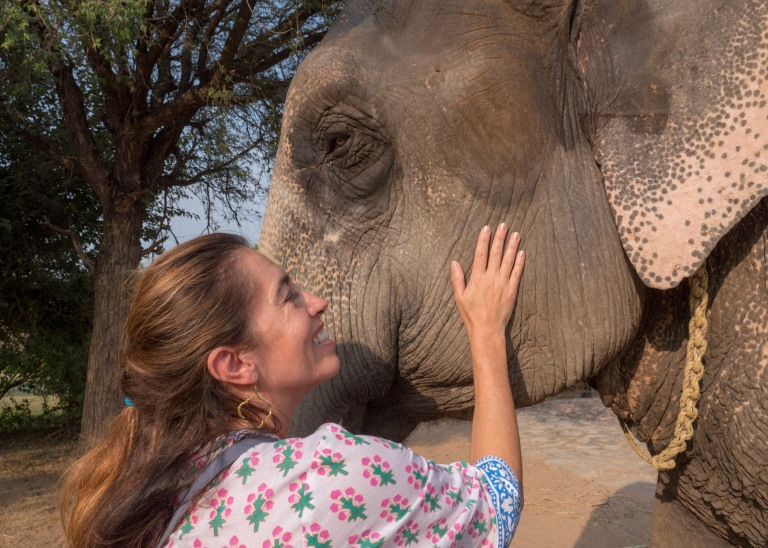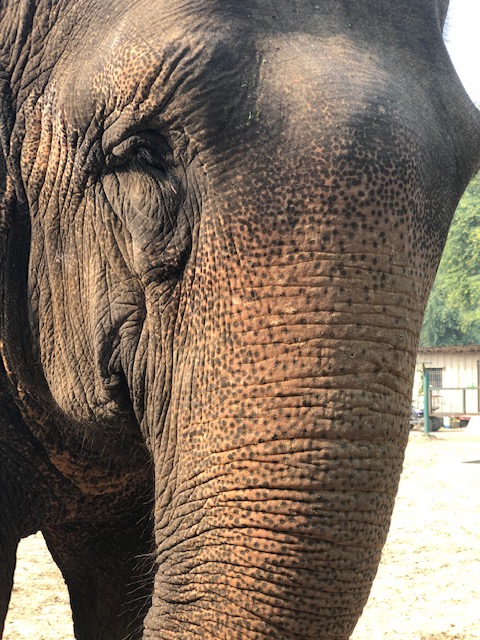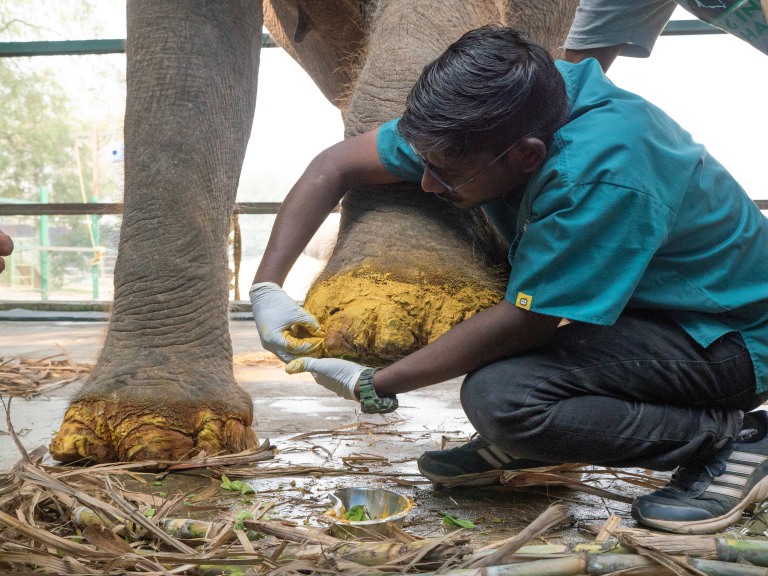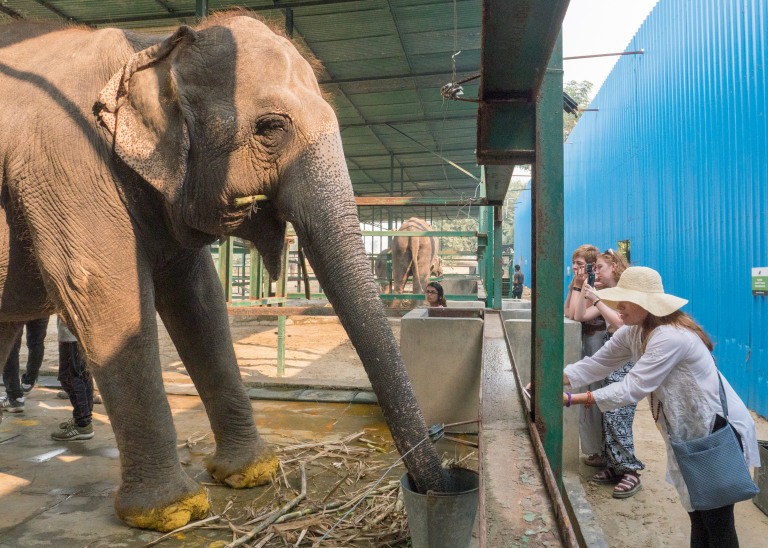This is very painful to admit because I should have known better. I’m smart but did something so unbelievably stupid, I can hardly believe it. It’s a sin I hope to remedy with awareness.
Here goes.
I am guilty of plopping my 137-pound body inside a heavy metal seat cage on top of an elephant so I could ride up a hill to the Amber Fort, just outside of Jaipur (Even as I write this I’m sick).
Honestly, I was swept up in the moment, wanting so desperately for something to be okay, even when the pit of my stomach told me it wasn’t.
“Of course you want to ride an elephant!” our guides told us. “That’s what you do at the Amber Fort.”
What about the treatment of the elephants?
I was assured the Indian government has strict rules to protect animals. They can only work a few hours. The elephants can give no more than five rides. They must have proper food, water, shelter, and care. It’s the law, I was told. The elephants are well-treated. Promise.
Her name was Madonna and I knew it wasn’t right when I sat down on the elephant’s back. I could see the rips in her ears, signs of her “training.” But maybe, I thought, those were from tussling with other elephants. I was stupid enough to ask the mahout (her handler) if the elephant was happy and even more naive to believe him when the elephant raised her trunk on cue. I was charmed.
Stupid. Stupid. Stupid me.
She raised her trunk because the mahout told her to with his prod.
Everyone I asked about this practice — my fancy hotel, my guides, and the Tripadvisor reviews worked to assure me this was not a bad thing.
It is true. The Indian government restricts and oversees the elephants. It’s true, the government has strict laws about how much elephants can work and how they and their handlers need to be treated.
Here’s the problem. Drive on any road in India and you’ll understand something fundamental about the culture. Rules? No one follows rules. As one guide told me, “If you follow a rule in India you feel like you are missing out.”
If you go on TripAdvisor.com you can get loads of information about elephant sanctuaries all over India, including the Elephant Village where most of the 102 privately owned elephants at the Amber Fort live. The reviews will show your pictures of lovely people bathing elephants, painting and petting elephants and riding them. Their stories are heartwarming and full of exuberance, people extolling their amazing, joy-filled hours while in proximity to one of the most beautiful, intelligent and astonishing creatures on earth.
Here’s what the reviews don’t tell you. In truth, many are blind, suffer from tuberculosis, and show signs of psychological suffering. Every one of those elephants is abused. Every. Single. One. They’ve been stolen from their herds as babies, often taken from their dead mothers and then chained and beaten until they submit. They live chained and are beaten again if they disobey. When they lie down to let a tourist paint or bathe them, it’s ONLY because the consequences are too much to bear otherwise. Our joy-filled entertainment is just another form of their torture.
Fuck. I’m such an idiot.
 There are 3000 elephants in captivity in India, most of those are working elephants. An owner of one of these animals can make $2000-$10000 a day off of their labor — hauling tourists on their backs in the morning, getting bathed and painted by kids in the afternoon, and walking down city streets for a wedding or temple procession in the evening. Their feet become broken on the hard asphalt. Their backs are disfigured by the weight of human bodies. Their legs are chained with barbed wire. They are prodded with sharpened steel dagger until they listen. They are starved if there is not enough business to feed them and left to beg in horrifying conditions.
There are 3000 elephants in captivity in India, most of those are working elephants. An owner of one of these animals can make $2000-$10000 a day off of their labor — hauling tourists on their backs in the morning, getting bathed and painted by kids in the afternoon, and walking down city streets for a wedding or temple procession in the evening. Their feet become broken on the hard asphalt. Their backs are disfigured by the weight of human bodies. Their legs are chained with barbed wire. They are prodded with sharpened steel dagger until they listen. They are starved if there is not enough business to feed them and left to beg in horrifying conditions.
As surreal and enchanting as it is to see an elephant walking the streets in India, the very fact that an elephant is on the streets means it is a slave in the worst sense of the word.
There is hope. I met two elephants who were rescued from the Amber Fort at a farm outside Jaipur called Dera Amer. Rescuing elephants is becoming more popular.

Dera Amer is a boho-chic glamping experience with safari-style tents, open-air dining, communing with nature, including elephants. We came for dinner and were invited to pet and feed their elephants when we arrived, just before their bedtime. The elephants were rescued from the Amber Fort because one was blind, the other was very ill. The owners of Dera Amer purchased the ailing animals from their owners to keep them from ending up as begging elephants. For a time they allowed tourist to ride the elephants but Dera Amer has come to realize, people like me will pay just to watch elephants walk around.
My real searing moment of clarity of the whole situation came a week later when I visited Wildlife SOS India, outside of Delhi.
If you go there, you’ll meet a selection of their 26 elephant guests, each with a backstory that will make you weep. Some still sway and bob their heads, a self-soothing technique to tame their tortured memories. These animals were not purchased in order to be saved. They were removed from owners using the Indian courts after appalling abuses were proven and no remedy was in sight.
Thank heavens some of the elephants, years after rescue, are healthy enough to be cocky and proud. You won’t need to pet them to feel your heart swell with the majesty of their faces or the quirky machinations of their trunks. If you love elephants, do go. It’s an amazing, healing place which has just opened the first Indian elephant hospital. They’ve got another 2974 more lives to liberate and they can’t do it without our money.
Their mission is simple: rescue every captive working elephant. Give them medical attention, healthy food and most of all, freedom. Not in the jungle, unfortunately. It’s too late for that, but on a preserve where they are never chained, never hurt and where they can roam within the limitations of donated land.
Even more importantly, if you want to help these elephants, you must do one thing: Tell everyone you know who goes to India why no one should ever ride an elephant. Never. Not in an “elephant village.” Not in an Indian nature preserve. Not a temple or wedding. Nowhere. We have to also stop treating them as oversized stuffed animals, to entertain our childish impulses, and remember their true nature is in a herd, communicating with their own kind, in a vast wild place.
Saving elephants from slavery is a process and Wildlife SOS India knows it. Indian culture is tied to the image of elephants as good luck. Every temple is decorated with the graceful arch of an elephant’s trunk. For hundreds of years the elephant has symbolized security in Indian life — as Ganesh, the god of luck, and as a wartime battering ram. Especially in Kerala, where the worst abuses occur and baby elephants are still being captured, the villages need to be educated and motivated to change their attitudes from dominators to protectors of elephants.
The rest of us have little excuse. Our privileged Angeleno culture is likely to treat animals with the utmost care, ushering spiders out of bathrooms without harming their spindly legs or treating our dogs like surrogate children, we are hyper animal aware. Circuses are out. Elephants in zoos are decried for having too little room, without question.
But what about #elephantsofInstagram!? It’s hard, I know. The ability to touch and commune with the elephants at Der Amer was truly magical. I would probably still go and feed and touch them there, but only if I were sure no one was riding an elephant and that their handlers use positive reinforcement, not chains or prods. But that’s the problem. In India it’s so very hard to be sure.
One thing I am sure of, I’m not the only misguided idiot out there. My penance, now, is to proselytize and convert.
India has given me meditation, a love of yoga pants, Shavasana, countless design inspirations, and some of my favorite travel experiences. Culture changes slowly, and then suddenly, all at once. Perhaps I can give something back to an Indian elephant by stopping one person from doing something stupid. Then, on a day not far in the future, elephant conservation in India will seem as ordinary as a yoga studio in Kansas.





i’m crying…this just breaks my heart…over and over….thank you for writing it.
LikeLike
My first non plastic toy was a beloved wooden carved elephant. I have spent a lifetime in awe of their kind majesty. To ride atop one would have been a glorious goal. Thank you for educating me on the dishonor I would have unwittingly committed.
LikeLike